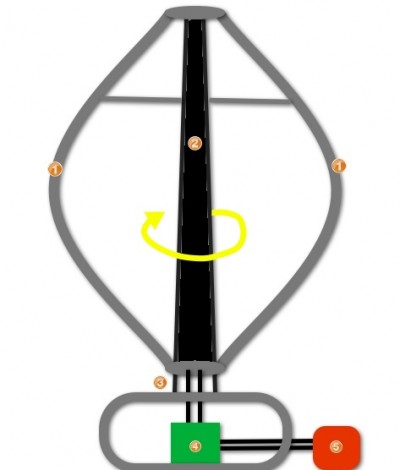Vertical Wind Turbine
A vertical wind turbine is just the opposite of the horizontal turbine because the rotating axis is vertical, or perpendicular to the ground.
The vertical wind turbine is not as commonly used as the horizontal wind turbine, but it does have a fair share of advantages compared to the horizontal wind turbine.
The diagram below is a Darrieus style vertical wind turbine.
The Darrieus wind turbine, sometimes called an “eggbeater” turbine was invented by the French inventor Georges Darrieus.
A big advantage of the vertical wind turbine is that it can begin to rotate from wind blowing in any direction.
The main inner workings of a vertical turbine (the generator and gear box) are located at the bottom of the turbine, near the ground.
This is another advantage of this style turbine because the inner machinery is easily accessible for maintenance.
Let’s take a closer look at how this vertical wind turbine works from the diagram below:
Here is a brief look at the components of the vertical wind turbine:
(1) The blades of the turbine work in similar fashion to those of the horizontal axis wind turbine, except that they rotate around a vertical axis.
(2) Notice the that the turbine is rotating in a fashion that is perpendicular to the ground.
(3) The central rotating turbine is attached to the inner workings of the machine, and is the main component that transfers the mechanical energy of the wind into the rotation energy that will later be used by the generator.
(4) The gear box allows high speed rotating turbines to attach to the turbine generator.
(5) The turbine generator will generate usable electric energy from the rotational energy.
The vertical wind turbine is most commonly seen in urban settings or in locations with dangerously high wind speeds, like on the side of mountains or cliffs.
